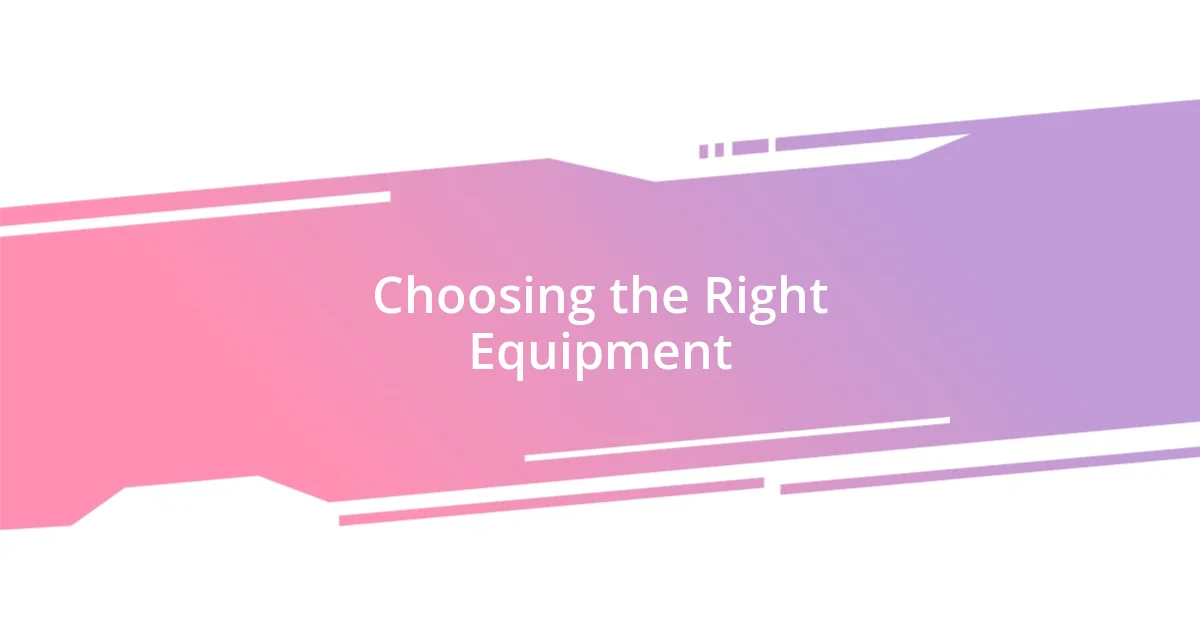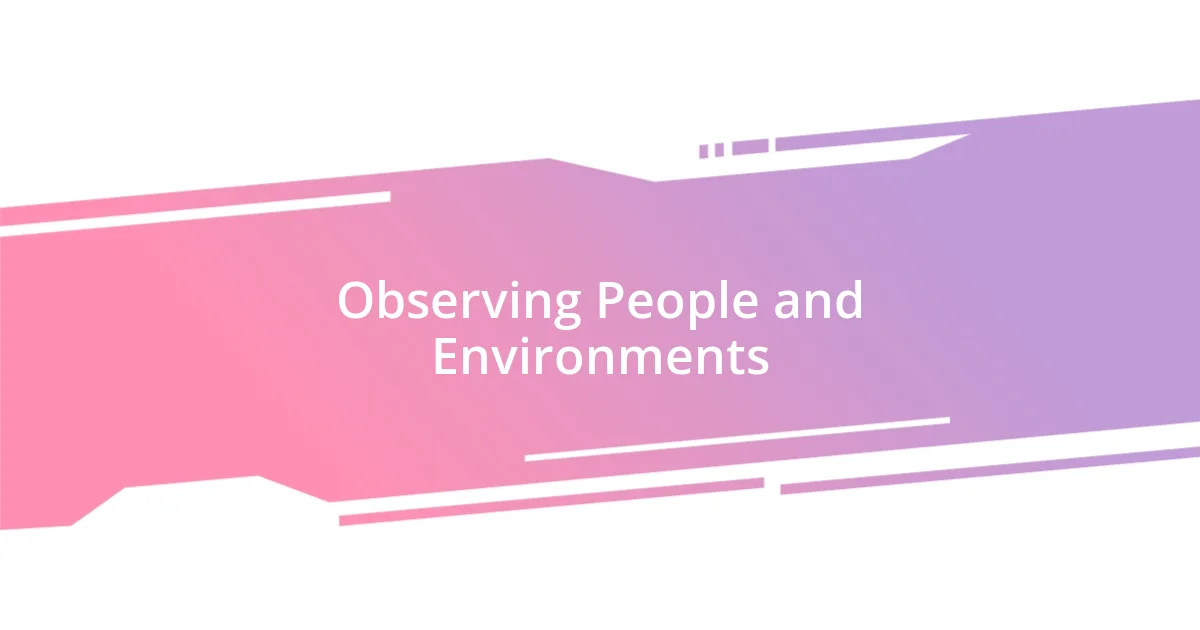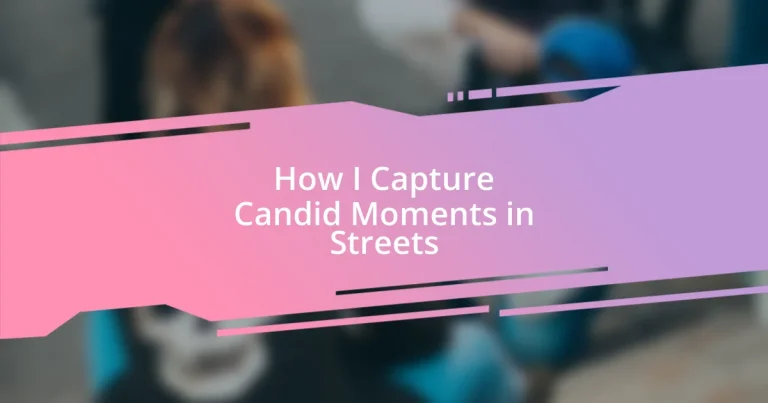Key takeaways:
- Candid photography captures authentic moments and human connections, revealing deep emotions and stories without staged setups.
- Choosing suitable equipment, including a lightweight camera, prime lens, and comfortable strap, enhances the ability to capture spontaneous moments effectively.
- Editing plays a crucial role in highlighting candid photographs, with techniques like cropping and color grading transforming raw images into engaging narratives.

Understanding Candid Photography
Candid photography is all about capturing genuine moments, often when people are least aware of the camera. I remember walking through a vibrant festival when I snapped a picture of a child joyfully chasing bubbles. The look of pure wonder on their face was magical; it’s those spontaneous expressions that truly breathe life into a photograph.
When I’m out shooting, I find that the best candid moments often happen in the most unexpected places. I once stumbled upon a couple sharing a quiet laugh on a busy street, completely caught up in each other’s world. It’s these fleeting instances that remind me of the beauty of human connection, don’t you think?
The essence of candid photography lies in its authenticity. Unlike posed shots, which can feel contrived, a genuine moment tells a story, revealing emotions and experiences that resonate deeply. Every click of the shutter becomes a little time capsule, preserving feelings and stories that we might otherwise overlook. Isn’t it fascinating how a single image can connect us to a moment, a feeling, or a memory?

Choosing the Right Equipment
Choosing the right equipment for candid photography significantly impacts the quality of your shots. In my experience, a camera that isn’t too bulky can make all the difference. I often reach for my compact mirrorless camera; it’s lightweight and quick to shoot, allowing me to blend into my surroundings without drawing too much attention.
When it comes down to lenses, I personally prefer a prime lens for its sharpness and low-light capabilities. For example, a 35mm lens gives me a nice perspective that feels natural—almost like I’m part of the scene rather than an observer. Plus, it’s versatile; whether I’m capturing a solitary figure or a bustling crowd, it performs beautifully in diverse settings.
Lastly, I can’t stress enough the importance of having a good strap. A comfortable strap not only makes it easier to carry the camera for long hours but also enables quick, spontaneous shots. I remember a day when I captured a street performer lost in their craft, and the ability to swiftly grab my camera without fumbling made that moment last forever.
| Equipment | Pros |
|---|---|
| Compact Mirrorless Camera | Lightweight, discreet, fast shooting |
| Prime Lens (35mm) | Sharp images, great in low light, natural perspective |
| Comfortable Strap | Easy to carry, allows quick shots |

Identifying Ideal Locations
Identifying ideal locations for candid photography often feels like a treasure hunt. I’ve found that some of the most captivating moments happen in places where people naturally congregate, yet don’t realize they’re being observed. Parks, bustling markets, or vibrant street corners are often gold mines for genuine expressions. I remember casually wandering through a lively flea market when I noticed a woman haggling with a vendor, her animated gestures and expressions were a story within themselves, bursting with life and emotion.
To help maximize your chances of capturing those spontaneous interactions, consider the following key spots:
- Public Parks: Children playing and parents chatting offer endless candid opportunities.
- Cafés with Outdoor Seating: Watch for spontaneous interactions between friends or families.
- Festivals and Events: The energy in these environments often leads to unexpected moments.
- Busy Streets: Waiting at a crosswalk can yield candid glances and reactions from passersby.
- Markets: The negotiation and exchange create an engaging backdrop for authentic moments.
By focusing on these locations, your chances of capturing those fleeting, candid emotions are significantly increased.

Observing People and Environments
Observing the dynamics between people and their environments opens up a world of emotional narratives. I often find myself lost in the little details—the way a child’s laughter dances through the air during an afternoon picnic, or how an elderly couple shares a quiet moment on a park bench. It’s these interactions that reveal the raw essence of life unfolding around us. Have you ever paused to watch a street musician drawing a crowd? The way the spectators engage, some smiling, and others lost in thought, speaks volumes about human connection.
As I explore the streets, I make it a point to take in the surrounding sights and sounds before lifting my camera. I remember a day spent near a bustling open-air market, where the aroma of spices filled the air. I noticed a vendor skillfully chopping vegetables while a curious child peeked over the stall, captivated. It struck me—what stories are hidden in these everyday exchanges? Each moment holds a thread of connection that often goes unnoticed.
Being attuned to the environment also means understanding how light and shadows play within a scene. I find that varying the time of day can yield markedly different moods—glistening morning light versus the warm glow of sunset can transform a simple interaction into something magical. Have you ever noticed how shadows can create drama in a photograph? The environment becomes a character itself, enriching the candid moments you’re there to capture.

Timing Your Shots Effectively
Timing your shots is all about predicting those fleeting moments that can change in the blink of an eye. I often find myself watching the ebb and flow of a scene, ready to click at the exact second when an expression shifts or a gesture speaks volumes. For instance, I was at a street festival, and there was a moment when a child burst into laughter just as a puppy scampered past. That split second was pure joy—and because I was prepared, I captured it beautifully.
In my experience, the best candid shots often come from a blend of patience and anticipation. I remember waiting at a busy corner in the city, feeling the rhythm of pedestrian traffic. Then, out of nowhere, a couple suddenly broke into dance, completely oblivious to the world around them. It was a spontaneous and magical moment that I couldn’t have predicted, but being poised with my camera allowed me to seize it. I always ask myself, “What’s happening here, and when?” That mindset helps me stay alert.
Experimenting with angles and focal lengths can also significantly impact the timing of your shots. I often crouch low or find unique perspectives to capture the surroundings while waiting for the perfect interaction. Just last week at a community garden, I spotted an older gentleman watering his plants while a group of children played nearby. By lowering my camera to their level, I not only got a unique angle but also captured the joy on their faces just as they frolicked into his frame. The right timing, combined with thoughtful composition, can result in revealing moments that resonate deeply.

Editing Candid Photographs
Editing candid photographs is truly where the magic happens. I’ve spent countless hours in front of my screen, sorting through images and finding the ones that speak to me. One time, I stumbled upon a shot of a street performer mid-expression, and while the raw capture was wonderful, a little adjustment to the contrast brought out the vibrancy of the moment. It felt like breathing new life into the image, making it sing.
I often think about how cropping can make a significant difference in focusing on the story being told within a candid moment. One memorable shot of a bustling café scene revealed a delightful interaction between two friends laughing. By cropping out some distractions in the background, I was able to create an intimate composition that drew attention right to their joyous expressions. Isn’t it fascinating how altering the frame can change the entire narrative?
Color grading is another tool in my editing arsenal that I love to play with. The atmosphere of a candid shot can shift dramatically based on color temperature and saturation. I remember editing a flashlight-bathed evening scene after a rainstorm; by enhancing the blues and yellows, it transformed the photograph from a simple moment to a captivating slice of life. It’s exhilarating to realize that the tiniest adjustment can evoke different emotions or transport viewers to that very moment.

Sharing and Showcasing Your Work
Sharing your work is where the joy of photography truly multiplies. I’ll never forget the first time I posted one of my candid street shots online; the comments and engagement made me feel like I was part of a larger community. It’s amazing how a simple photograph can spark conversations, allowing everyone to share their interpretations and personal stories. Have you ever shared a moment captured in time and watched it resonate with others? That connection is what motivates me to keep sharing my work.
In my experience, showcasing your photos through social media platforms can be both thrilling and daunting. I remember feeling nervous the first time I created an Instagram profile dedicated solely to my street photography. But taking that step led to unexpected opportunities, like collaborations with local artists and invitations to showcase my work at galleries. It’s a reminder that sharing isn’t just about exposure; it can blossom into genuine connections and growth.
Don’t underestimate the power of a well-curated portfolio, either. I created one after receiving lots of fantastic feedback on my Instagram. By organizing my best works into a cohesive collection, I found my voice more clearly and it helped others see the depth of my perspective. When potential clients or collaborators view your work, that curated flow communicates your creative journey. Each piece tells a story, and I enjoy letting them unfold together, creating an impactful narrative that leaves viewers wanting to learn more about the moments behind the lens.












